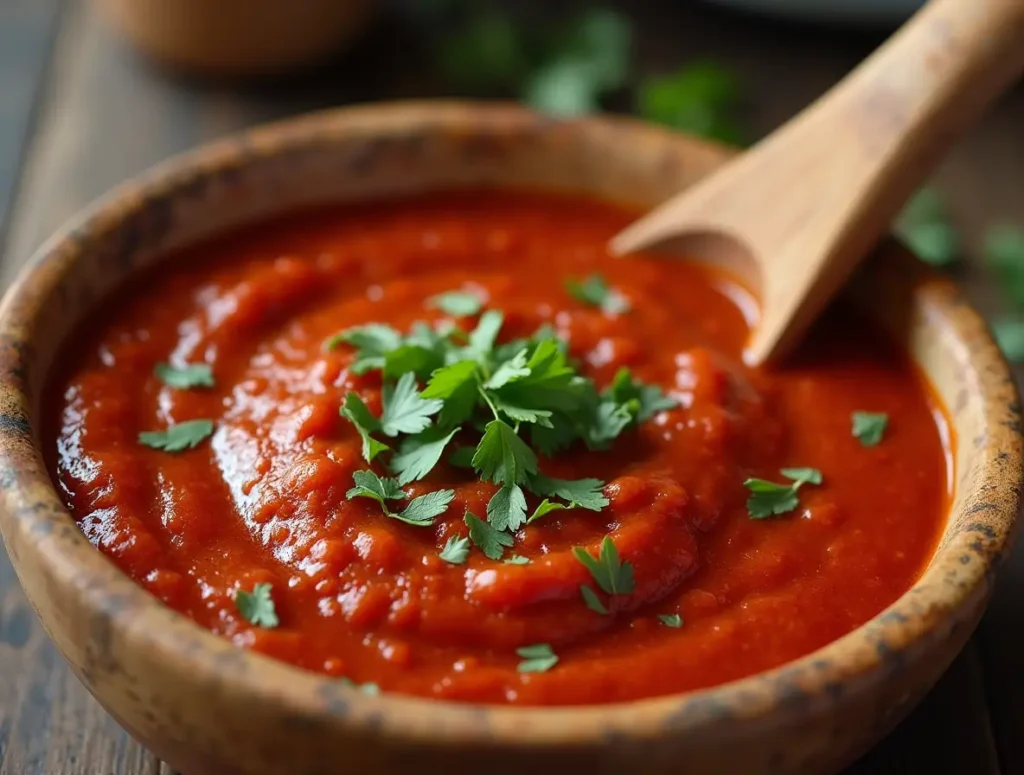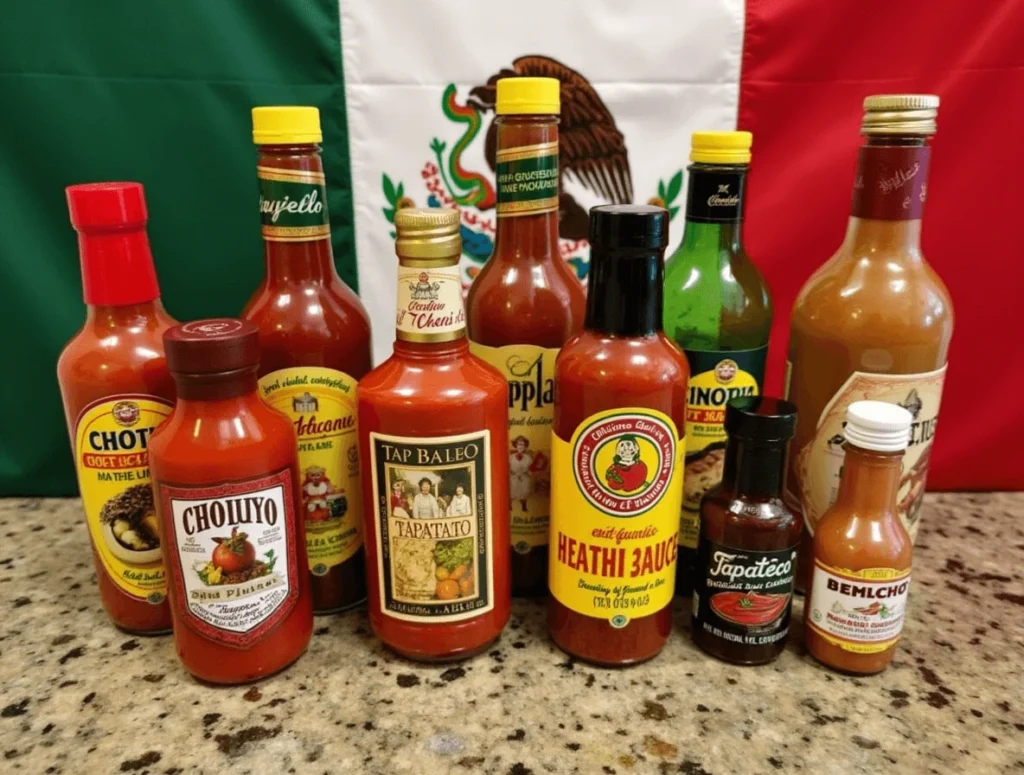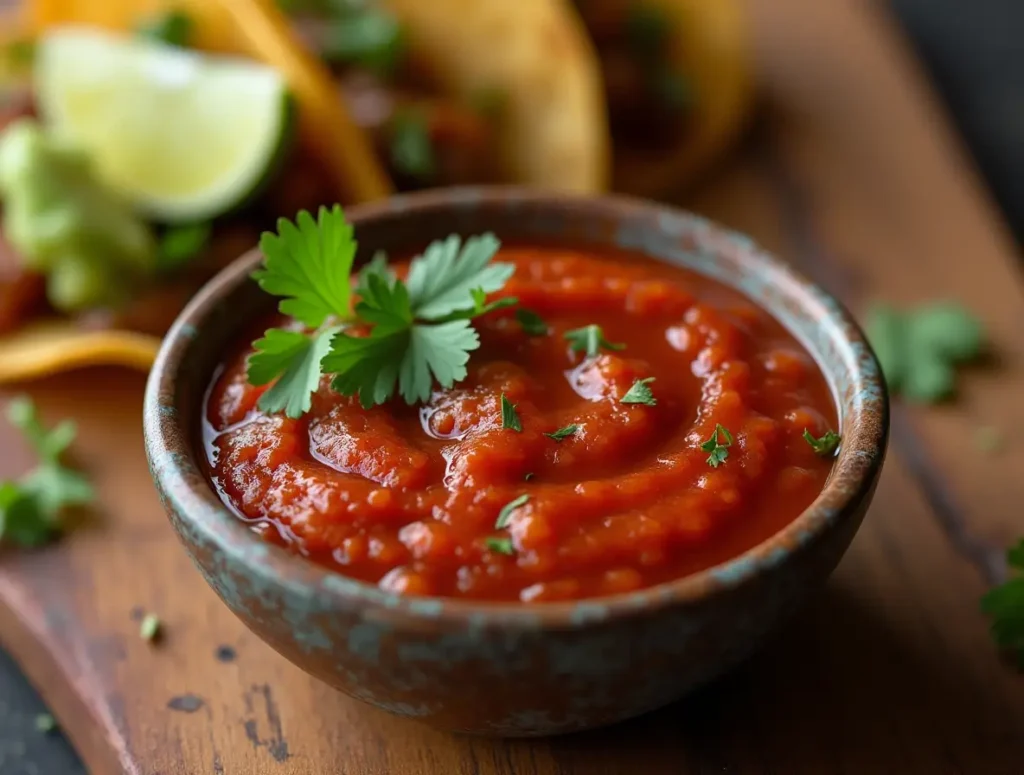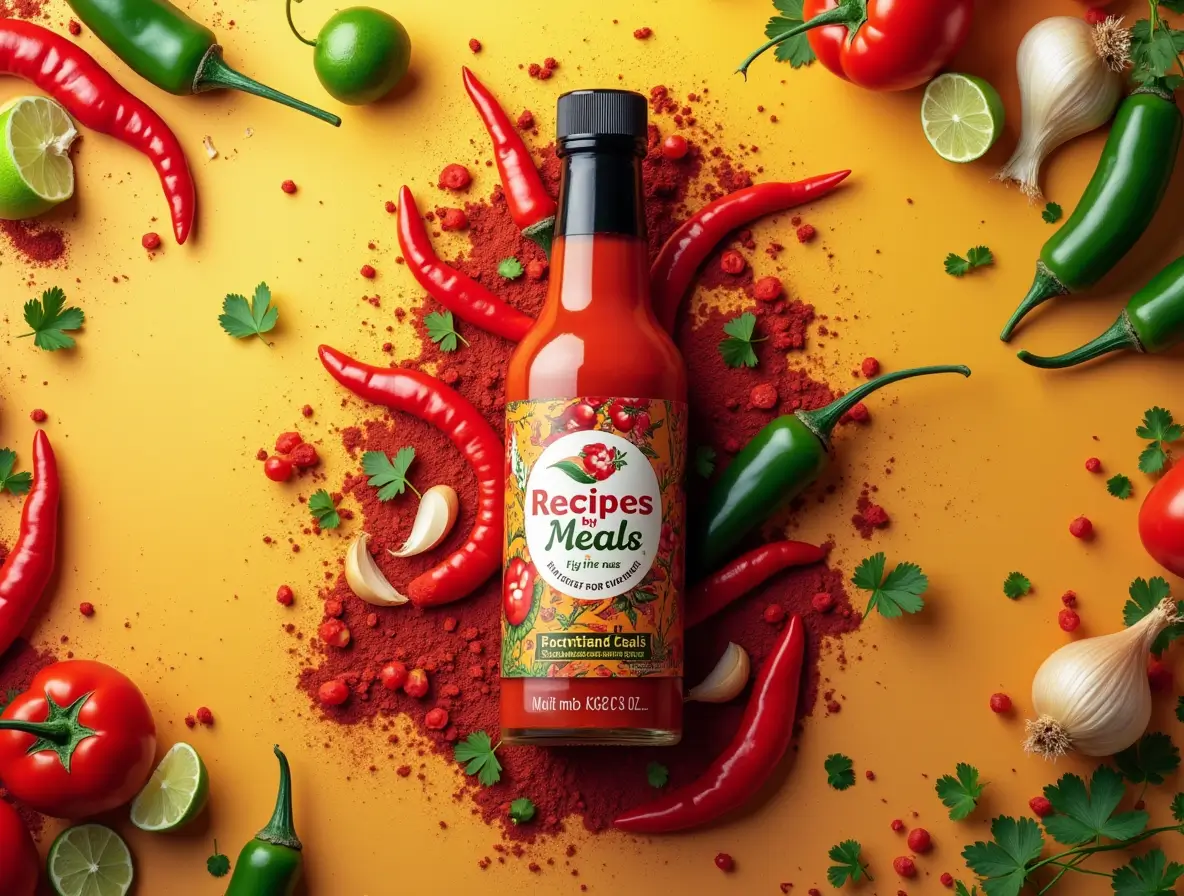Table of Contents
Mexican hot sauces are the heart and soul of Mexican cuisine, offering a perfect blend of heat, flavor, and spice. These vibrant sauces are more than just condiments; they are an integral part of Mexican culture, elevating dishes with their rich, smoky, tangy, and fiery profiles. From tacos to grilled meats, Mexican hot sauces add a bold, zesty kick that enhances every bite. Made from an array of fresh ingredients like chilies, garlic, and lime, each sauce is unique in its heat level and flavor, making it easy for anyone to find a perfect match for their taste buds.
Whether you’re a fan of mild heat or crave a sauce that packs a fiery punch, there’s a Mexican hot sauce out there that’s just right for you. Let’s explore some of the most popular options and learn what makes them so irresistible!

What Makes Mexican Hot Sauces Unique?
Mexican hot sauces stand out not only for their heat but for the incredible depth of flavour they bring to a variety of dishes. These sauces are an essential part of Mexican cuisine, offering a balance of spice, tanginess, and smokiness that is unparalleled in many other cultures. Whether mild or fiery, each sauce has its own unique taste profile that complements everything from tacos to grilled meats.
Tasting Notes of Traditional Mexican Hot Sauces
The beauty of Mexican hot sauces lies in their complex layering of flavors. Traditional sauces often combine heat, tanginess, and smokiness, creating a multi-dimensional taste experience. The heat typically comes from the chilis, but the other elements balance out the spiciness. Tanginess is often achieved through the use of ingredients like lime or vinegar, providing a refreshing contrast to the heat. Smokiness is a hallmark of sauces made from dried peppers, like Chipotle or Ancho, which lend a deep, earthy flavour. Together, these elements create a sauce that can add a punch to any dish without overpowering it.
The Role of Peppers in Flavor
At the heart of every Mexican hot sauce is the pepper. The variety and quality of peppers used define the sauce’s flavor and heat level. Some of the most popular peppers in Mexican cuisine include:
- Jalapeño: A mild to medium heat pepper that is bright, crisp, and slightly grassy. It’s often used in fresh, vibrant hot sauces that pair well with foods like tacos and grilled vegetables.
- Chipotle: A smoke-dried jalapeño, chipotles add a rich, smoky flavor that is less about heat and more about a deep, earthy taste. Chipotle sauces are commonly used in meats like pulled pork and chicken.
- Habanero: Known for its fiery heat, Habanero peppers are often used in sauces designed to bring a powerful punch. These peppers are fruity and floral in flavor, adding complexity to sauces used for spicy lovers.
- Serrano: Slightly milder than Habanero, Serrano peppers bring a crisp, fresh flavor and moderate heat. These peppers are great for those who want a medium spice level with an unmistakable bite.
Each pepper used in these sauces contributes to the sauce’s distinct heat and flavor profile, making Mexican hot sauces some of the most versatile and delicious condiments in the culinary world.
Authentic Ingredients Used
The distinct taste of Mexican hot sauces comes from the use of authentic, fresh ingredients. These ingredients play a crucial role in shaping the unique flavors of the sauces.
- Garlic: A common ingredient in many Mexican hot sauces, garlic adds depth and richness. It provides a savory, aromatic base that balances the heat of the peppers.
- Lime: The bright, zesty flavor of lime adds a tangy element that cuts through the richness of the sauce, enhancing the other flavors without overpowering them.
- Chili Powder: Often made from a blend of dried peppers, chili powder provides a more subtle heat and an earthy flavor. It is commonly used in combination with other spices like cumin and oregano to create a well-rounded sauce.
- Vinegar: Vinegar is frequently used in Mexican hot sauces to bring acidity, balancing the heat and adding a sharp note that elevates the overall flavor.
These authentic ingredients come together in various combinations to create sauces that are both spicy and flavorful, often with a complexity that makes them so addictive. Whether drizzled over tacos, stirred into salsas, or used as marinades, these hot sauces enhance the dish with an unforgettable burst of flavor.

Top 5 Mexican Hot Sauces You Need to Try
Mexican hot sauces vary widely in flavor and heat, making them perfect for a wide range of dishes. Here are the top five Mexican hot sauces that you must try, each with its own unique flavor profile and uses:
RELATED : Raising Cane’s Sauce Recipe: Step-by-Step Guide
How to Make Chick-fil-A Sauce: Easy Copycat Recipe
1. Cholula – Famous for Its Balanced Flavor, Ideal for Tacos and Burritos
Cholula is a household name in the world of hot sauces. This sauce is celebrated for its perfect balance of heat and flavor, making it one of the most versatile Mexican hot sauces available. Cholula has a mild heat level, derived from arbol and piquin chilies, making it ideal for people who want a flavorful kick without overwhelming their taste buds. The sauce has a slightly tangy profile thanks to the addition of vinegar and garlic, giving it a bright and zesty flavor that pairs perfectly with tacos, burritos, and even scrambled eggs.
Uses:
- Drizzle it on tacos, burritos, and grilled meats for that perfect boost of flavor.
- Add it to salsa or guacamole for an extra kick.
- Use it to spice up scrambled eggs or omelets for a satisfying breakfast.
2. El Yucateco – Known for Its Fiery Habanero Heat and Great for Spicy Food Lovers
For those who love bold, fiery flavors, El Yucateco is a must-try. Known for its intense habanero heat, this sauce is perfect for spicy food lovers who enjoy a serious kick. El Yucateco offers various varieties, but its most famous is the Red Habanero Sauce, which provides a sharp, intense heat balanced by a mild sweetness from tomatoes and carrots. This sauce packs a punch but doesn’t compromise on flavor.
Uses:
- Pair it with grilled steaks, chicken wings, or burgers for an intense, spicy experience.
- Add a few drops to salsa or hot wings for a real kick.
- Try it as a marinade for meats or seafood before grilling.
3. Tapatío – A Go-To Mexican Sauce for Versatility, Perfect for Everything from Fries to Eggs
If you’re looking for a versatile hot sauce that complements a wide variety of foods, Tapatío is the go-to choice. With its moderate heat level and well-rounded flavor profile, Tapatío is perfect for just about anything, from French fries to scrambled eggs, and everything in between. Its tangy yet mild heat comes from a blend of chili peppers, garlic, and vinegar, making it a favorite for everyday use.
Uses:
- Drizzle it over fries, nachos, or potatoes for added flavor.
- Mix it into eggs, omelets, or scrambled eggs for a perfect breakfast.
- Top your tacos or grilled veggies for a flavorful finish.
4. Valentina – A Tangy Sauce with Mild Heat, Popular for Chips and Snacks
Valentina is one of the most popular Mexican hot sauces, known for its tangy flavor and mild heat. The sauce is made from a combination of dried chili peppers, vinegar, and garlic, giving it a deep, flavorful kick without being overwhelmingly hot. Valentina is commonly used for adding flavor to chips, fruits, and snacks, and is particularly loved for its ability to enhance the taste without overpowering it.
Uses:
- Drizzle over tacos, potato chips, or popcorn for a tangy, spicy twist.
- Use it on fresh fruit such as pineapple or mango for a refreshing snack.
- Add it to Mexican street corn (elote) for an authentic flavor.
5. La Costeña – A Brand Offering Different Heat Levels, with a Mild Yet Flavorful Taste
La Costeña offers a wide range of Mexican hot sauces, catering to all heat preferences. From mild to hot, this brand is known for delivering bold flavors that are perfect for both everyday meals and special occasions. La Costeña’s hot sauce range includes varieties made from jalapeños, chipotles, and tomatoes, each with its own unique flavor profile. The mild options offer a pleasant heat and are perfect for those who want to enjoy flavor without too much spice.
Uses:
- Try it on tacos, grilled chicken, or meat for a flavorful addition.
- Use it to enhance your salsa or guacamole for a mild to medium heat boost.
- Add a dash to rice or beans to make a simple dish more exciting.
Each of these sauces brings a distinct flavor to the table, making it easy for anyone to find a Mexican hot sauce that suits their taste. Whether you like a mild tang or a fiery heat, these hot sauces are perfect for spicing up any meal!
The Difference Between Salsa and Hot Sauce
When it comes to Mexican cuisine, salsa and hot sauce are two of the most popular condiments. While they share a common foundation in chilies and spices, they differ significantly in texture, flavor, and usage. Understanding these differences will help you choose the right condiment for your dishes and appreciate the unique qualities each brings to the table.

What is Salsa?
Salsa is typically a chunky, textured condiment made from a variety of fresh ingredients like tomatoes, onions, cilantro, garlic, and chili peppers. Unlike hot sauce, which is smooth and liquid, salsa’s consistency allows it to be spooned or scooped onto dishes, often offering a refreshing contrast in texture to the food it accompanies.
There are various types of salsa, ranging from salsa fresca (fresh salsa), which uses raw ingredients, to salsa cooked (like salsa roja), where ingredients are roasted or simmered for a deeper, richer flavor. Salsa can also be made with a base of fruits like mango or pineapple, which add a sweet twist to the heat from the peppers.
When to Use Salsa vs. Hot Sauce
Both salsa and hot sauce are versatile, but they work best in different situations. Here’s a breakdown of when to use each one:
- Salsa: Best for dishes where a chunky, fresh texture is desired. Salsa works beautifully on tacos, burritos, and nachos, as well as a topping for grilled meats or fish. It’s also perfect as a dip for chips, bringing a juicy, vibrant burst of flavor to every bite.
- Hot Sauce: Ideal for dishes that need a smooth, even coating of spice. Hot sauce can be used in cooking or garnishing. Drizzle it on eggs, soups, steaks, or sandwiches to infuse them with a spicy kick. It’s often used as a finishing touch, adding a kick to tacos, fajitas, or enchiladas, but without the chunkiness that salsa brings.
How Mexican Hot Sauces Complement Salsas
While salsa and hot sauce can be used separately, they often work wonders when combined. The key difference in texture between the two allows them to complement each other, balancing both flavor and heat.
For example, while salsa provides a fresh, chunky element to tacos or grilled meats, a few drops of hot sauce can intensify the heat and spice, rounding out the flavor profile. Mexican hot sauces, such as Cholula or Valentina, have a smoother consistency that can seep into the crevices of tacos or burritos, amplifying the bold flavors without overwhelming the dish.
In fact, some of the most beloved taco trucks and street vendors will offer a combination of both—salsa for the refreshing, savory burst of flavor and hot sauce to elevate the heat to the perfect level. By using both, you can create a symphony of flavors, ensuring each bite is full of contrast and depth.
How to Choose the Right Mexican Hot Sauce for Your Dish
Selecting the perfect Mexican hot sauce for your dish can be a fun and flavorful experience. The key is understanding your taste preferences and matching them to the right heat level and flavor profile. Whether you like your sauces mild or scorching hot, there’s a Mexican hot sauce that fits your taste. Here’s how you can navigate the world of Mexican hot sauces:
Mild vs. Spicy Hot Sauces: How to Pick the Right Heat Level for Your Preference
When it comes to heat, Mexican hot sauces range from mild to fiery. The heat level is typically determined by the type of chili used in the sauce. For those new to spicy food or anyone who prefers subtle heat, starting with a mild sauce like Valentina or Cholula is a great choice. These sauces offer a balanced flavor with just enough heat to enhance your dish without overwhelming your taste buds.
If you’re a seasoned spice lover, sauces made from Habanero or Ghost Pepper, such as El Yucateco or Dave’s Insanity, will deliver a serious kick. When picking a hot sauce, consider the Scoville heat scale, which measures the intensity of heat in peppers, and choose a sauce with a Scoville rating that matches your tolerance for spice.
Pairing Sauces with Dishes: Example Pairings, Like Cholula for Tacos or El Yucateco for Grilled Meats
The right hot sauce can elevate a dish, complementing its flavor profile and enhancing its overall taste. Here are some ideal pairings to inspire you:
- Tacos: A classic pairing is Cholula, which has a mild heat and a tangy, vinegar-based flavor that perfectly complements the savory filling of tacos. It pairs well with beef, chicken, or pork tacos.
- Grilled Meats: If you’re grilling meats, such as steak or chicken, opt for a spicier sauce like El Yucateco or Tapatío. These sauces have a bold flavor that stands up well to smoky, charred meats and brings out their richness.
- Fish and Shrimp: For seafood dishes, a lime-infused hot sauce, like Valentina, adds a zesty kick without overpowering the delicate flavor of the fish or shrimp. It’s great for tacos, ceviches, or grilled fish.
- Eggs and Breakfast Dishes: Cholula or Tapatío are excellent choices to drizzle over scrambled eggs, omelets, or breakfast burritos. These sauces add flavor without overwhelming the eggs’ natural taste.
Balancing Heat with Flavor: Why Flavor Should Always Be Prioritized Over Sheer Heat
While many love the thrill of extreme heat, it’s important to remember that a good hot sauce is more than just spice. The best Mexican hot sauces balance flavor with heat, offering a complexity of taste rather than just an overwhelming burn. A sauce that’s too hot can mask the other flavors in your dish, leaving you with a one-dimensional experience.
For example, Chipotle-based sauces like La Costeña provide smoky depth along with heat, making them perfect for grilled meats or roasted vegetables. Similarly, a sauce with a touch of lime or tomato can enhance the freshness of a dish while providing a mild level of spice.
When choosing a hot sauce, always taste the sauce before drizzling it on your dish. Ensure that it not only brings heat but also adds a layer of complementary flavor. Prioritizing flavor will ensure that your dish is both spicy and delicious!
How to Make Your Own Mexican Hot Sauce at Home
Making your own Mexican hot sauce at home is a rewarding experience that allows you to experiment with flavors and adjust the heat to your liking. Whether you’re a spice enthusiast or someone who enjoys milder sauces, crafting a homemade hot sauce can be fun and easy. Here’s a step-by-step guide to help you create the perfect Mexican hot sauce using fresh ingredients like Habanero, Jalapeño, and Garlic.

Basic Recipe for Homemade Mexican Hot Sauce: Ingredients like Habanero, Jalapeño, and Garlic
The foundation of any good Mexican hot sauce lies in the chilies and aromatic ingredients. For a versatile and flavorful sauce, you’ll need:
- Habanero peppers: Known for their fiery heat and slightly fruity flavor, Habaneros are a classic choice for adding a bold kick.
- Jalapeño peppers: These milder peppers balance out the heat of the Habanero, making the sauce more approachable for those who prefer less intensity.
- Garlic: A staple in Mexican cuisine, garlic brings a savory depth and richness to the sauce.
- Onion: Adds a sweet and savory balance to the peppers.
- Tomato: While optional, a small amount of tomato can help mellow the heat and provide a smoother texture.
To begin, roast the peppers, garlic, and onion until they develop a charred exterior. This imparts a smoky flavor, which is characteristic of many traditional Mexican hot sauces. Blend these roasted ingredients with a bit of salt and water to achieve your desired consistency.
Adjusting the Heat: Tips for Controlling the Spiciness by Adding or Reducing Peppers
One of the great things about making your own Mexican hot sauce is that you can adjust the heat level to suit your personal preferences. Here’s how you can control the spiciness:
- For more heat: If you want your hot sauce to pack a serious punch, keep the seeds and membranes of the peppers. This is where most of the heat resides, so leaving them in will intensify the spiciness.
- For a milder sauce: To tone down the heat, remove the seeds and membranes from the Habanero and Jalapeño peppers. You can also reduce the number of Habaneros in your sauce, using more Jalapeños or even milder peppers like Serrano or Poblano.
- Balancing with vinegar or lime: If the sauce becomes too spicy, balancing it with a little vinegar or lime juice can help counteract the heat while adding a zesty flavor.
Experimenting with different combinations of peppers will allow you to find the perfect balance of heat and flavor for your homemade hot sauce.
Blending with Other Ingredients: How to Mix in Lime, Vinegar, and Tomato for Depth of Flavor
A great Mexican hot sauce isn’t just about heat—it’s also about achieving a complex depth of flavor. Here’s how you can take your sauce to the next level:
- Lime: Fresh lime juice adds a bright, tangy note that cuts through the heat and gives the sauce a refreshing edge. It’s a key ingredient in many Mexican sauces, providing that signature citrusy bite.
- Vinegar: A splash of vinegar—whether white, apple cider, or even rice vinegar—gives the sauce a slightly acidic balance. This helps mellow out the spiciness while adding an extra layer of flavor.
- Tomato: For a smoother, more mellow sauce, adding tomato can enhance the flavor profile. The natural sweetness of the tomato balances the acidity from the lime and vinegar, creating a harmonious sauce that pairs well with a variety of dishes.
- Herbs and spices: Feel free to experiment with fresh herbs like cilantro, or spices like cumin and oregano. These can elevate the sauce and add a more authentic Mexican taste.
Blending all of these ingredients together in the right proportions will create a well-rounded hot sauce that brings the perfect balance of heat, tang, and depth of flavor.
NOTE Chef's
Making your own Mexican hot sauce at home allows you to customize it exactly how you want—whether you like it extra spicy or with a little more sweetness. Play around with the ingredients, and soon you’ll have your own signature sauce to add to tacos, grilled meats, or even as a dipping sauce for chips!
Conclusion
Making your own Mexican hot sauce at home is a fun and flavorful adventure that allows you to personalize your spice experience. Whether you prefer a fiery sauce with Habaneros or a milder version with Jalapeños, the possibilities are endless. By adjusting the heat, adding fresh ingredients like lime, garlic, and tomatoes, and experimenting with different pepper combinations, you can create the perfect sauce to complement your meals.
So, next time you’re craving that extra kick, why not try crafting your own homemade Mexican hot sauce? With just a few simple steps, you can enjoy the bold, zesty flavors of authentic Mexican cuisine right in your own kitchen.
FAQ About Mexican Hot Sauces
Print
homemade Mexican hot sauce recipe
- Total Time: 30 minutes
- Yield: 12 servings
Description
This easy homemade Mexican hot sauce recipe combines the bold flavors of jalapeños, habaneros, garlic, and fresh tomatoes. Perfect for spicing up tacos, burritos, or any favorite meal!
Notes
- Calories: 10 kcal
- Fat: 1 g
- Carbohydrates: 2 g
- Protein: 0 g
- Fiber: 0.5 g
- Sugar: 1 g
- Prep Time: 10 minutes
- Cook Time: 20 minutes
- Category: Condiments, sauce
- Cuisine: Mexican
Nutrition
- Calories: 10
Keywords: homemade hot sauce, Mexican hot sauce, spicy sauce recipe
1. What are the main ingredients in Mexican hot sauces?
Mexican hot sauces typically contain chili peppers (like Habanero, Jalapeño, or Serrano), garlic, onions, tomatoes, vinegar, lime juice, and salt. These ingredients create a balance of heat, tang, and depth of flavor.
2. How can I control the heat level of my Mexican hot sauce?
To adjust the heat, you can modify the number and type of peppers used in your sauce. Removing the seeds and membranes from the peppers will reduce the heat, while leaving them in will increase it. Additionally, using milder peppers like Poblano or Anaheim will create a less spicy sauce.
3. How do I store homemade Mexican hot sauce?
Store your homemade Mexican hot sauce in an airtight container in the refrigerator. It should stay fresh for up to 2-3 weeks. The flavors will continue to develop as the sauce sits, making it even tastier over time.
4. Can I make a milder Mexican hot sauce for my family?
Absolutely! For a milder sauce, opt for peppers like Jalapeños or Poblanos. You can also reduce the number of spicy peppers, remove the seeds, or add ingredients like tomato and sugar to balance out the heat.
5. What dishes pair best with Mexican hot sauces?
Mexican hot sauces are perfect for adding a spicy kick to tacos, burritos, grilled meats, eggs, quesadillas, or even roasted vegetables. Use them as a condiment or mix them into your favorite Mexican dishes for extra flavor.
6. Can I use Mexican hot sauce as a marinade?
Yes! Mexican hot sauces make a great marinade for chicken, beef, pork, or even fish. The acidity from the vinegar and lime in the sauce helps tenderize the meat while infusing it with bold flavors.
7. What are the most popular Mexican hot sauce brands?
Some of the most popular Mexican hot sauce brands include Cholula, Tapatío, Valentina, and El Yucateco. Each of these brands offers a variety of heat levels and flavor profiles, from mild to fiery hot.
8. How do I make a smoky-flavored Mexican hot sauce?
To achieve a smoky flavor, consider using chipotle peppers or roasting your peppers, garlic, and onions before blending them into the sauce. The charred flavors from roasting will add that signature smokiness.


